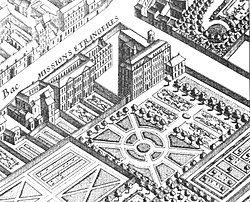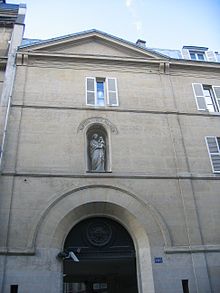Rue du Bac
Coordinates: 48 ° 51 ' N , 2 ° 19' E
| Rue du Bac | |
|---|---|
| location | |
| Arrondissement | 7th |
| quarter | Saint-Thomas-d'Aquin |
| Beginning | 35, Quai Voltaire and 1, Quai Anatole-France |
| The End | 24, rue de Sèvres |
| morphology | |
| length | 1150 m |
| width | 20 m |
| history | |
| Original names | Grand chemin du Bac Ruelle du Bac Grande rue du Bac |
| Coding | |
| Paris | 0605 |
The Rue du Bac is a street on the Rive Gauche , the left bank of the Seine in Paris ( 7th arrondissement ). She is known for the apparitions of the Blessed Virgin Mary, which are said to have shown themselves here several times to the nun Catherine Labouré in 1830 .
Its name is derived from the river ferry ( French bac ) that went into operation in 1550 at the bottom of the street , which gained in importance when Catherine de Medici met the architect Philibert Delorme in 1564 with the building of the Tuileries Palace across the river His commissioned. Instead of having to laboriously transport the building material from the quarries much further south - today's catacombs under Place Denfert-Rochereau - over the only bridges that existed at the time and the Ile de la Cité , i.e. through the city center, the stones were transported across country Meadows and pastures to take the ferry across.
The resulting grand chemin du bac ("Great Ferry Route") did not get its fringing until 1620, initially very hesitantly before the new suburb of Faubourg Saint-Germain came into fashion in the 18th century. Since then, the street has undergone numerous changes through widening and in particular the construction of the Boulevard Saint-Germain under Baron Haussmann .
Course of the road
The grand chemin du bac followed the course of today's Rue Notre-Dame-des-Champs , Rue Saint-Placide and Rue du Bac . Behind the chemin de la Maladrerie (now Rue de Sèvres ) it led past the cemetery of the Hospice des Petites Maisons hospital . This replaced the old Maladrerie Saint-Germain , founded in 1497, in 1557 , was later rebuilt several times, and finally, after it was renamed Hospice des Petits Ménages in 1801 , demolished in 1868 and replaced by Square Boucicaut . Not far from there was later, from 1689 until its abolition in 1747, a cemetery, the Cimetière de la Trinité of the parish of St-Sulpice de Paris .
Religious communities
The Rue du Bac, like many other streets around Paris at the time, developed through the establishment of religious communities.
From the year 1631 the intersection with was at the northeast corner of Boulevard Saint-Germain , the novitiate of the Dominicans . The monastery church based on a design by Pierre Bullet from 1682 to 1765 was rededicated as a parish church after the revolution. A side entrance to this church of St. Thomas d'Aquin is on Rue du Bac (N ° 37).
The Recollettes or Filles de l'Immaculée-Conception-de-la-Vierge Marie were located between the present-day streets of Rue de Grenelle and Rue de Varenne from 1637 until the abolition of their convent in 1790 . Behind it was a male monastery of the Récollets between 1658 and 1708 .
The former Séminaire des Missions Etrangères (seminar of the foreign missions ), today Société des Missions Etrangères and in German for short Paris Mission , settled in 1663 in the Rue du Bac (N ° 128). A first chapel ( Chapelle de la Sainte-Famille ) replaced today's second Chapelle St. François-Xavier from 1683 . The seminary was renewed in 1736 , with the exception of the building at the back of the garden in which a room called the Salle des Martyrs commemorates the missionaries who died for their faith. It was closed after the outbreak of the French Revolution in 1792, sold in 1796 and refurbished in 1805.
The monastery buildings of the Couvent de la Visitation-Sainte-Marie , founded in 1673 between the present-day Rue Paul-Louis Courier and Rue de Grenelle , were demolished in 1796, together with the church built by the architect Hélin in 1775, and the site was parceled out (N ° 68 to 80).
The Cooperative of the Daughters of Christian Love of St. Vincent de Paul ( Compagnie des Filles de la Charité ) came into the possession of the Hôtel de la Vallière in 1815 , where they set up their mother house, which is still there today (N ° 140 ).
In the chapel of this community, the Blessed Virgin Mary appeared to novice Catherine Labouré three times in total in 1830 . These phenomena led to the spread of the " Miraculous Medal ", which in turn prepared the understanding of the dogma of the immaculate conception proclaimed in 1854 for many people .
The Church confirmed these apparitions with the introduction of the feast “The Blessed Immaculate Received Virgin Mary of the Miraculous Medal”, which is celebrated as a separate festival in the Vincentian communities ( Lazarists or Vincentians or Sisters of Mercy of Saint Vincent de Paul) .
Secular buildings
When the Faubourg Saint-Germain came into fashion in the 18th century, the Hôtels particuliers (city palaces) listed below were built on the Rue du Bac .
The Hôtel de la Feuillade (N ° 101), named after a later owner, and the two palaces known under the double name Hôtels de Clermont-Tonnerre (N ° 118 and 120) were built around 1715, the latter allegedly for two bishops of the Paris Missionary Seminar . The writer Chateaubriand († 1848) spent the last years of his life there.
The palace, named after Henri-Gabriel Segur, who owned it from 1795 (N ° 97), dates from 1720 .
The Hôtel de Jacques-Samuel Bernard was built by the architect Germain Boffrand between 1741 and 1744 for the wealthy heir of the financier of the same name (N ° 46).
The Hôtel particulier (N ° 102), inhabited around 1850 by the Count of Sainte-Aldegonde and named after him, was also built in the 18th century .
Varia
- The later writer George du Maurier (1834-1896) lived on this street between 1847 and 1851 before he had to leave Paris and move to his father in London (see also: List of residential addresses of George du Maurier ).
- The inventor Étienne Lenoir (1822–1900) spent the last years of his life in house N ° 114.
- A Klezmer piece by Giora Feidman is named after the Rue du Bac .
- The Secours catholique relief organization has its headquarters on Rue du Bac .
literature
- Bruno Pons et Anne Forray-Carlier (author), La Rue du Bac , Paris, Délégation à l'action artistique de la ville de Paris, 1991 ISBN 2905118334
Individual evidence
- ↑ Pierre-Hubert, Viscount d'Aubusson et marquis de la Feuillade
- ^ Daphne du Maurier: The Du Mauriers , Heron Books, p. 147
- ↑ Revue de la Société d'Entraide des Membres de la Légion d'Honneur, No. 107
Web links
- Revue de la Société d'Entraide des Membres de la Légion d'Honneur, No. 107, May 1990, pp. 16–18: Biography Jean-Joseph Étienne Lenoir (1822–1900) (French, PDF, 88 KiB) (accessed on July 19, 2013)



